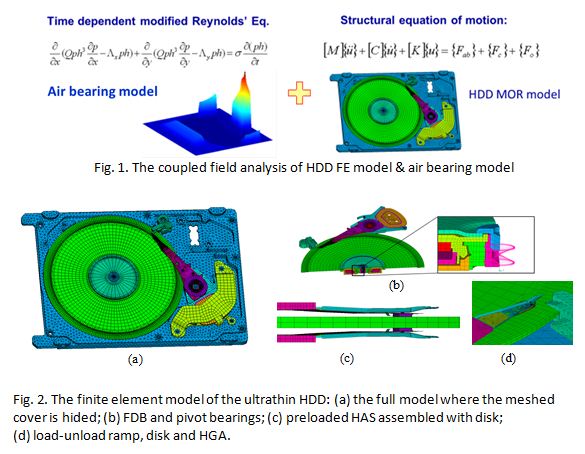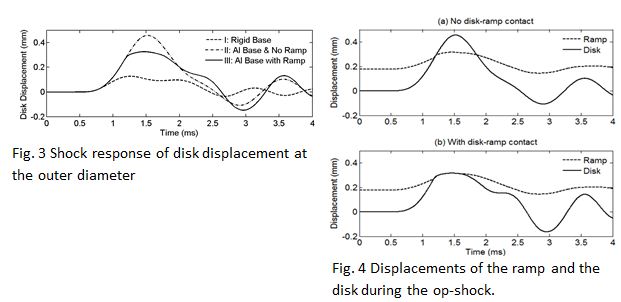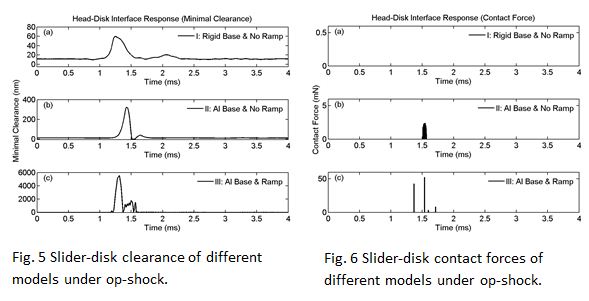Operational Shock Modelling of HDDs
From A*STAR, Data Storage Institute
This is a Press Release edited by StorageNewsletter.com on August 4, 2015 at 3:08 pmIn this study, the DSI (Data Storage Institute) HDI modeling and simulation team developed a two-way coupled-field analysis method to integrate the air bearing model with the full structural FE model of a 5mm thin ultrathin HDD design, including all the major mechanical components, such as disk, HGA, arm, actuator, spindle, ramp, base, cover, etc., so as to study the coupling effects of HDD structural dynamics on the HDI responses during the operational shock.
By Yu Shengkai, Mou Jianqiang, Hua Wei, Zhou Weidong and Tan Chye Chin (Drive Systems and Technologies Division) Data Storage Institute, Agency for Science Technology and Research (A*STAR), Singapore.
The mechanical robustness during the operational shock (op-shock) is of great concern for the ultrathin mobile hard disk drives (HDDs) due to the reduced thickness and stiffness of their mechanical components. Owing to lack of understandings on the op-shock response of HDDs, especially the nonlinear effects such as disk-ramp contacts, the design optimisations for improving op-shock resistance are mainly based on plenty of experiments which are expensive and lengthy. The op-shock simulation needs to solve the air bearing-structure interaction problem, i.e. interactions of the structural dynamics and the air bearing dynamics between the slider and the disk. The conventional op-shock simulations adopts the one way decoupled method which uses the linear springs to replace the air bearings in the structural finite element (FE) model to calculate the shock loads first, and then these loads are applied to the slider for dynamic air bearing simulations to obtain the head-disk interface (HDI) responses. This decoupled method works well for cases with low level of shock excitations when the simulation model still can be considered as linear. However, it will be invalid at the high level of shock excitations due to the strong non-linearities, such as the disk-ramp contacts and slider-disk contacts.
DSI HDI modeling and simulation team proposes a two-way coupled field analysis method to integrate the air bearing model with the structural finite element (FE) model of the full HDD, including all the major mechanical components, such as disk, HGA, arm, actuator, spindle, ramp, base, cover, etc. so that the coupling effects of structural dynamics of these components on the slider flying dynamics and HDI responses during the op-shock can be investigated. In this method, the time-dependent Reynolds equation and the structural dynamics equation of motion are solved successively at each time step until the change is smaller than the convergence criterion. Due to the large scale of the HDD’s FE model, a model order reduction (MOR) method is also developed to reduce the scale of the model so that the computation efficiency is significantly improved. Fig. 1 shows the schematic of the proposed model and method.
In this study, a full structural FE model for a 5 mm thick ultrathin HDD design has been developed using ANSYS where the meshed cover is hiddden, as shown in Fig. 2(a). This model includes all key mechanical components of the HDD, such as the base, spindle motor, disk, head suspension assembly (HSA), VCM actuator, pivot, ramp, and cover. In particular, stiffness and damping matrices of the fluid dynamic bearings (FDB) of the motor spindle and the pivot bearings are modelled with matrix27 elements, as shown in Fig. 2(b). The structure of the HSA and the load-unload ramp are also included in the finite element model of the ultrathin HDD, as shown in Fig. 2(c) and 2(d).
Click to enlarge
A series of simulations have been done for a 5mm thin HDD with 5400 rpm under a 400G 2ms half sine shock pulse. Three cases are studied here: (I) the HDD with an assumed rigid base; (II) the HDD with the aluminium base but no ramp; and (III) the HDD with the aluminium base and the ramp. It is found that the maximum disk displacement in Case I (rigid base) is 127µm only while it is 453µm in Case II (aluminium base). When the disk-ramp contact is considered in Case III, the amplitude of disk displacement is reduced by 30%, as shown in Fig. (3).
More importantly, the base deformance during the op-shock may significantly affect the disk-ramp contact. For the rigid base model, the maximum disk displacement is 127µm which is smaller than the disk ramp gap (180µm). However, when the base flexibility is considered, the disk displacement increases to 453 µm which far exceeds the disk ramp gap, though the ramp node also has a small displacement due to the deformation of the ramp under the shock load, as shown in Fig. 4(a). If the disk-ramp contact is considered, the ramp will restrict the displacement of the disk so that the disk and the ramp keep contacting, as shown in Fig. 4(b).
Click to enlarge
Slider disk clearances and contact forces in Cases I, II and III are also compared in Fig. 5 and 6, respectively. From the simulation results, it can be found that the drive base deformation and disk-ramp contact play a critical role for the operational shock resistance performance of ultrathin HDDs. At the shock of 400G @ 2ms, the rigid base model gives the smaller flying attitude response, and no head-disk contact occurs. When the deformation of the drive base is considered in the model of HDD with the aluminium base and no ramp, the flying attitude response is much larger, and minor head-disk contacts are observed. When the deformable base and ramp are included in the model, the slider lift-off and slider disk contacts occur.
The results reveal that the disk-ramp contact will lead to the head-disk contact under the operational shock with 2ms half sine shock pulse and degrade the operational shock resistance of the head-disk interface. The stiffer base will decrease the relative motion between the disk and the ramp, so as to reduce the disk-ramp contact force, and therefore, decrease the possibility of HDI failure and enhance the operational shock resistance performance of HDDs. More parametric studies and design optimisations based on this model and method can be carried out for improving the op-shock resistance performance of HDDs.

















 Subscribe to our free daily newsletter
Subscribe to our free daily newsletter

